Spotlight on Booze: Gin
Posted by Bob Westal (11/28/2011 @ 5:58 pm)
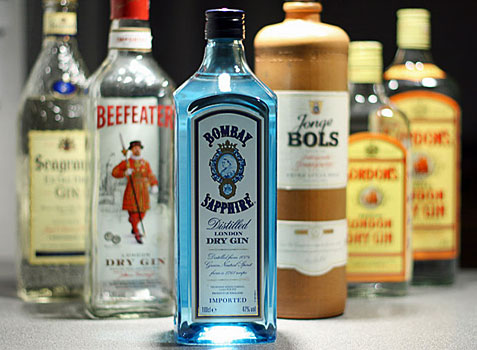
It’s lost some commercial ground to vodka over the decades, but the revival of interest in classic cocktails has given gin a boost lately. In any case, this venerable liquor remains the standard clear alcohol among serious cocktail aficionados, who strongly prefer its more complex flavor and swear it’s the only true main ingredient in a martini.
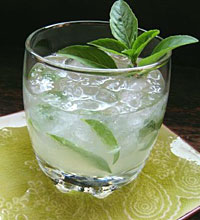 Gin is distilled from grain, usually wheat or rye, and starts out as a fairly plain spirit probably not so different from vodka. After that, “distilled gins” are then distilled a second time with various flavorings. The most prominent being juniper berries. That’s only for starters, as gin manufacturers use a pretty vast assortment of herbs and other botanicals ranging from licorice root to grapefruit peels to the perfumey bergamot we associate with Earl Grey tea. Some ultra-cheap brands are “compound gins.” These gins are not redistilled, but simply have tiny infusions added — they’re basically gin-flavored alcohol.
Gin is distilled from grain, usually wheat or rye, and starts out as a fairly plain spirit probably not so different from vodka. After that, “distilled gins” are then distilled a second time with various flavorings. The most prominent being juniper berries. That’s only for starters, as gin manufacturers use a pretty vast assortment of herbs and other botanicals ranging from licorice root to grapefruit peels to the perfumey bergamot we associate with Earl Grey tea. Some ultra-cheap brands are “compound gins.” These gins are not redistilled, but simply have tiny infusions added — they’re basically gin-flavored alcohol.
Most modern gins are “dry” and manufactured in England; these gins legally may not contain any added sugar and that aids in the liquor’s superb mixability. As far as we can tell, however, there isn’t much predictable difference between “London dry, “extra dry,” and other similar designations. “Plymouth” gins technically only have to come from the coastal town, but they tend to have a somewhat more complex, pungent, and slightly sweeter flavor profile. Largely produced in Holland and Belgium, genever is a less strong gin variant popular in central Europe. With plenty of added sugar, you can still find very sweet “old Tom” gin if you look hard. Speaking of sweet, you’ve likely had a slurp or two or of “sloe gin,” actually a liqueur made with gin or cheaper neutral spirits mixed with sloe berries. Most brands of gin are between 84 and 92 proof (42-46 percent alcohol), but a number of less upscale mass market brands are available at 80 proof or even less.
Like all types of booze, gin is available in a number of price levels, but there’s not really any such thing as a super premium gin. While you can easily spend $150.00 or much more on a bottle of small batch bourbon or single malt Scotch, if you find a bottle of regular size bottle of gin selling for more than $50.00, you’re probably paying mostly for ultra-fancy packaging. Some of the best and/or most popular premium gins include Tanqueray Ten, Plymouth (a brand as well as style of gin), and Bombay Sapphire. Just as good or better, in our opinion, are the mid-priced premiums, available in some states at discounters like Costco, Bev-Mo and Trader Joe’s. These include Tanqueray, Bombay Dry Gin (less heavy on the perfumey juniper berries than Sapphire), and Hendricks, an increasingly popular Scottish gin we like quite a bit. A bit cheaper, still quite good, and very rich in “Mad Men”-style classic street cred, is Beefeater.
Read the rest of this entry »
Posted in: Food & Drink, Lifestyle, Vices
Tags: bath tub gin, Beefeater, Bombay Dry Gin, Bombay Sapphire, booze, Casino Royale, compound gin, distilled gin, Dr. Franciscus de la Boe, gin, gin brands, gin cocktail, gin history, Glorious Revolution, Gordon's Gin, Hendrick's, liquor, London dry, mad men, mixology, old Tom gin, Plymouth, sloe gin, spirits, Tanqueray Ten, Turpentine, Vesper, William of Orange
Check out the new Don Julio 70 Añejo Claro tequila
Posted by Bullz-Eye Staff (11/21/2011 @ 9:44 am)
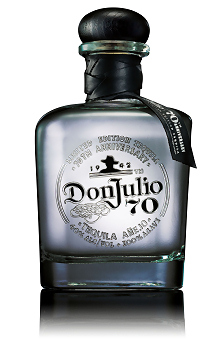 Don Julio has introduced a new addition to its portfolio of ultra-premium tequilas in celebration of the 70th anniversary of the year Don Julio González began perfecting the art of tequila making – the world’s first Añejo Claro tequila, Tequila Don Julio 70. The good folks at Don Julio were good enough to send us a sample so we could enjoy their new creation. What we found was a unique flavor that tequila fans will love.
Don Julio has introduced a new addition to its portfolio of ultra-premium tequilas in celebration of the 70th anniversary of the year Don Julio González began perfecting the art of tequila making – the world’s first Añejo Claro tequila, Tequila Don Julio 70. The good folks at Don Julio were good enough to send us a sample so we could enjoy their new creation. What we found was a unique flavor that tequila fans will love.
The Añejo Claro tequila combines traditional Añejo flavors that result from 18 months of barrel aging with the fresh agave flavor and silver color expected from an unaged Blanco tequila. The result is tequila with a smooth and complex flavor of an Añejo that is specially filtered to bring back the crisp agave flavor typically found in a Blanco. Once the tequila has reached maturity, it is carefully filtered through a custom process that restores the citrus and fruity agave flavor notes that are muted during the aging process to a more concentrated strength, resulting in a stronger flavor of the tequila’s raw materials. The filtration process makes the tequila return to a clear silver color while maintaining the flavor of an Añejo.
Check it out as the new Don Julio 70 Añejo Claro tequila also makes a great gift this holiday season.
Posted in: Food & Drink, Lifestyle, Vices
Tags: 2011 holiday gift guide, Añejo Claro tequila, booze, Don Julio, Don Julio 70, Don Julio tequila, gift guide, gift guide for guys, gift guide for men, Holiday Gift Guide, holiday gift guide for guys, holiday gift guide for men, liquor, premium tequila, spirits, tequila
Spotlight on Booze: Canadian Whisky
Posted by Bob Westal (11/13/2011 @ 1:41 pm)
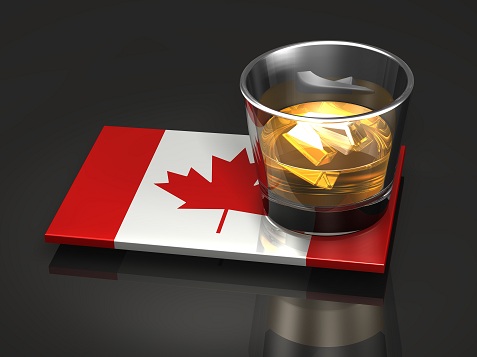
Make no mistake, this is not only your dad’s but also your grandfather’s whiskey. Depending on your age and where your family was during prohibition, it might even be your great-great-grandfather and/or grandmother’s whiskey. Say what you like about Canadian whisky, it’s stood the test of time.
 Sometimes referred to, particularly in Canada, as rye despite the fact that it’s primarily made with corn spirits, Canadian whisky, unlike now resurgent American rye whiskey, never threatened to go away. Still, while some uninformed bartenders still think rye is just the name of a type of Jewish bread, it’s the rare bar that doesn’t stock Seagram’s V.O., Canadian Club, Crown Royal and often Black Velvet. Its the even rarer connoisseur or cocktail aficionado who will admit to being excited about them, with some liquor snobs deriding Canadian as “brown vodka.” Following their lead, younger drinkers who have taken to premium brands of bourbon and Scotch, have largely ignored it. That’s not to say unassuming Canadian Whisky has no fans among the cognoscenti. We kind of love it and no less an authority than cocktail historian David Wondrich suggests Canadian Club — a value-priced favorite of ours — as the perfect vehicle for an Old Fashioned, the most purist-friendly whiskey cocktail we know.
Sometimes referred to, particularly in Canada, as rye despite the fact that it’s primarily made with corn spirits, Canadian whisky, unlike now resurgent American rye whiskey, never threatened to go away. Still, while some uninformed bartenders still think rye is just the name of a type of Jewish bread, it’s the rare bar that doesn’t stock Seagram’s V.O., Canadian Club, Crown Royal and often Black Velvet. Its the even rarer connoisseur or cocktail aficionado who will admit to being excited about them, with some liquor snobs deriding Canadian as “brown vodka.” Following their lead, younger drinkers who have taken to premium brands of bourbon and Scotch, have largely ignored it. That’s not to say unassuming Canadian Whisky has no fans among the cognoscenti. We kind of love it and no less an authority than cocktail historian David Wondrich suggests Canadian Club — a value-priced favorite of ours — as the perfect vehicle for an Old Fashioned, the most purist-friendly whiskey cocktail we know.
In any case, pop culture seems to be slowly becoming more aware of American rye whiskey’s almost-as-retro northern cousin. The 2008 primary elections saw Hillary Clinton swigging a much-discussed shot of Crown Royal, the very smooth Chivas Regal of Canadian. Though the label is angled so that the logo is just slightly out of our view, it’s clear that Canadian Club — first brewed by distilling legend Hiram Walker — is Donald Draper’s poison of choice on “Mad Men.” (In the first episode, newbie secretary Peggy Olson is informed that rye is the same as Canadian, and told it’s what her new boss drinks.) It also sure looks to be Canadian Club that washing up on the Jersey shore in HBO’s bootlegging themed early gangland drama, “Boardwalk Empire.” By law, Canadian whisky must be aged at least three years, though Canadian Club and Seagram’s V.O. are both aged for six
In fact, the popularity of Canadian whisky — which many insist must be spelled sans “e” — in the U.S. goes back to those dark days for everyone but gangsters between 1920 and 1933 when the sale and manufacture of liquor was illegal in the land of free and home of the brave, but thoroughly legal up north. Jewish-Canadian entrepreneur and liquor distributor Samuel Bronfman became wealthy and powerful beyond anyone’s wildest dreams by staying more or less on the right side of the law while doing business with the likes of Al Capone. He purchased Joseph E. Seagram’s and Sons and launched what became, for a time, a massive commercial and media empire. (It’s worth noting that the line’s flagship brand, Seagram’s 7 Crown, best known as the non-7-Up ingredient in a “7 and 7,” is not technically Canadian whisky. The U.S. version, at least, is bottled in Indiana and marketed as “an American whiskey,” whatever that is.)
Since it’s primarily blended and is generally not a very complex kind of a whiskey, it’s likely that Canadian will never have the cachet of bourbon, rye, or Scotch, but its hipness quotient may be improving slightly. Canadian Club has shrewdly played on its history with a series of attention-grabbing print ads with the slogan “Damn right, your dad drank it.” The ads alluded to the allegedly racy lifestyles of fathers of yore and used actual family photographs from Canadian Club employees.
As for cocktail and liquor aficionados, New York Times writer Robert Simonson blogged some time ago that his contacts in the gourmet and mixology worlds became obviously bored at the mere mention of Canadian whisky. However, Simonson’s April 2011 article details how there are real changes brewing in the world of Canadian booze. He specifically cites the highly acclaimed Forty Creek distillery and also attempts by better known makers of Canadian whiskey to brew blends that will appeal to drinkers used to the more complex flavors of today’s premium whiskeys.
Forty Creek does appear to be the most prevalent of the “new style” Canadian whisky manufacturers and we were able to pick up a bottle on sale at out local big-box beverage emporium. Our reaction was a bit mixed; we still think Canadian Club is more tasty and given its extremely low price, difficult to beat. Even so, we anxiously await the arrival of more and better Canadian whiskys. It’s time to see if our polite and funny friends to our north can create some premium whiskeys that will give some real competition to Kentucky and Tennessee, not to mention Scotland and Ireland.
Posted in: Food & Drink, Lifestyle, Vices
Tags: 7 and 7, Al Capone, bartending, best Canadian whiskeys, Black Velvet, Boardwalk Empire, Boardwalk Empire blog, booze, Canadian Club, Canadian whiskey, Crown Royal, David Wondrich, Don Draper, Don Draper whiskey, Forty Creek, HBO, liquor, mad men, Mad Men blog, Mad Men booze, Mad Men whiskey, mixology, Old Fashioned, premium whiskeys, Prohibition, purist whiskey cocktail, Robert Simonson, Samuel Bronfman, Seagram's, Seagram's 7 Crown, Seagram's V.O., spirits, Spotlight on Booze, whiskey, whiskey brands, whiskey cocktail, whiskey history, whiskey on TV
Everyone loves Johnnie Walker Scotch
Posted by Bullz-Eye Staff (06/13/2010 @ 5:26 pm)
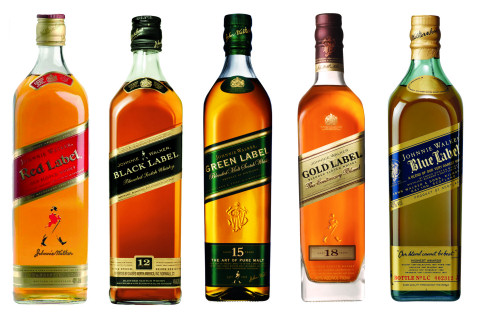
The gang at Johnnie Walker was kind enough to send us some samples of each of the scotch bottles above. Needless to say, productivity at Bullz-Eye headquarters immediately plummeted.
It did, however, give us another great idea for a Father’s day gift. Booze may not be the most creative gift, but it’s usually a winner with most fathers, particularly when it involves great Scotch.
You see above that you can choose among five different “labels” for Johnnie Walker, each with a different color. Check out the web site and you can choose the best one for you or the lucky gift recipient. After extensive taste testing, we’re partial to Johnnie Walker Black Label and Johnnie Walker Blue Label.
Two hundred years in the making, Black Label is the signature blend from the House of Walker. Big whisky flavors with hints of rich fruit and smoke make this Scotch whisky the perfect gift for the father who stands strong as the cornerstone of his family. You can’t lose with this one, and at a retail price of around $34 it won’t break the bank.
If you’re looking to spend a tad bit more, try the Blue Label which runs around $220. This is the rarest, most exceptional whisky from Johnnie Walker, and it’s a good choice if you’re looking for a more memorable gift. Just make sure you’re around when he opens the damn thing!
Posted in: Food & Drink, Lifestyle
Tags: booze, drinks, Johnnie Walker, Johnnie Walker Black Label, Johnnie Walker Blue Label, liquor, Scotch, Scotch whisky, spirits, whiskey, whisky
Drink of the Week – Captain and Cola in honor of Captain Morgan’s 375th birthday
Posted by Bullz-Eye Staff (05/14/2010 @ 3:32 pm)
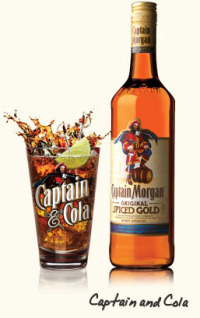 Believe it or not, Captain Morgan has been around for roughly 350 years! So, they’re celebrating Captain Morgan’s “375-ish” birthday on May 15th – it’s hard to be really precise when you’re dealing with hundreds of years.
Believe it or not, Captain Morgan has been around for roughly 350 years! So, they’re celebrating Captain Morgan’s “375-ish” birthday on May 15th – it’s hard to be really precise when you’re dealing with hundreds of years.
In honor of the Captain, Diageo sent us some samples, and we’ve been getting reacquainted Captain Morgan Original Spiced Rum, while tasting Captain Morgan Lime Bite and Captain Morgan Black Cask 100 Proof Spiced Rum for the first time. Great stuff!
For this week’s Drink of the Week, we decided to go with an old favorite made with some Captain Morgan.
Captain and Cola
1.5 oz. Captain Morgan Original Spiced Rum (25 oz. per bottle)
3 oz. cola
1 lime wedge
Drink Recipe Preparation:
o Add Captain Morgan Original Spiced Rum and cola in ice-filled highball glass.
o Garnish with lime wedge.
It’s simple and easy, but it’s a classic and it’s refreshing as hell.
Posted in: Food & Drink, Lifestyle, Vices
Tags: booze, Captain and Cola, Captain Morgan, Captain Morgan 375, Captain Morgan birthday, Captain Morgan drinks, cocktails, Diageo, Drink of the Week, drink recipes, Happy Hour, liquor
 Gin is distilled from grain, usually wheat or rye, and starts out as a fairly plain spirit probably not so different from vodka. After that, “distilled gins” are then distilled a second time with various flavorings. The most prominent being juniper berries. That’s only for starters, as gin manufacturers use a pretty vast assortment of herbs and other botanicals ranging from licorice root to grapefruit peels to the perfumey bergamot we associate with Earl Grey tea. Some ultra-cheap brands are “compound gins.” These gins are not redistilled, but simply have tiny infusions added — they’re basically gin-flavored alcohol.
Gin is distilled from grain, usually wheat or rye, and starts out as a fairly plain spirit probably not so different from vodka. After that, “distilled gins” are then distilled a second time with various flavorings. The most prominent being juniper berries. That’s only for starters, as gin manufacturers use a pretty vast assortment of herbs and other botanicals ranging from licorice root to grapefruit peels to the perfumey bergamot we associate with Earl Grey tea. Some ultra-cheap brands are “compound gins.” These gins are not redistilled, but simply have tiny infusions added — they’re basically gin-flavored alcohol.



 Sometimes referred to, particularly in Canada, as rye despite the fact that it’s primarily made with corn spirits, Canadian whisky, unlike now resurgent American rye whiskey, never threatened to go away. Still, while some uninformed bartenders still think rye is just the name of a type of Jewish bread, it’s the rare bar that doesn’t stock Seagram’s V.O., Canadian Club, Crown Royal and often Black Velvet. Its the even rarer connoisseur or cocktail aficionado who will admit to being excited about them, with some liquor snobs deriding Canadian as “brown vodka.” Following their lead, younger drinkers who have taken to premium brands of bourbon and Scotch, have largely ignored it. That’s not to say unassuming Canadian Whisky has no fans among the cognoscenti. We kind of love it and no less an authority than cocktail historian
Sometimes referred to, particularly in Canada, as rye despite the fact that it’s primarily made with corn spirits, Canadian whisky, unlike now resurgent American rye whiskey, never threatened to go away. Still, while some uninformed bartenders still think rye is just the name of a type of Jewish bread, it’s the rare bar that doesn’t stock Seagram’s V.O., Canadian Club, Crown Royal and often Black Velvet. Its the even rarer connoisseur or cocktail aficionado who will admit to being excited about them, with some liquor snobs deriding Canadian as “brown vodka.” Following their lead, younger drinkers who have taken to premium brands of bourbon and Scotch, have largely ignored it. That’s not to say unassuming Canadian Whisky has no fans among the cognoscenti. We kind of love it and no less an authority than cocktail historian 










